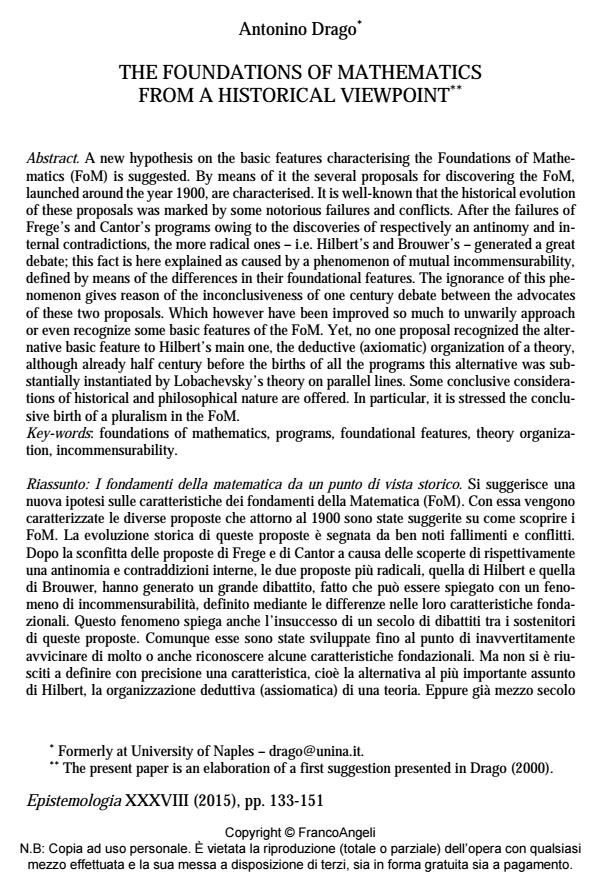The foundations of mathematics from a historical viewpoint
Titolo Rivista EPISTEMOLOGIA
Autori/Curatori Antonino Drago
Anno di pubblicazione 2015 Fascicolo 2015/1
Lingua Inglese Numero pagine 19 P. 133-151 Dimensione file 98 KB
DOI 10.3280/EPIS2015-001009
Il DOI è il codice a barre della proprietà intellettuale: per saperne di più
clicca qui
Qui sotto puoi vedere in anteprima la prima pagina di questo articolo.
Se questo articolo ti interessa, lo puoi acquistare (e scaricare in formato pdf) seguendo le facili indicazioni per acquistare il download credit. Acquista Download Credits per scaricare questo Articolo in formato PDF

FrancoAngeli è membro della Publishers International Linking Association, Inc (PILA)associazione indipendente e non profit per facilitare (attraverso i servizi tecnologici implementati da CrossRef.org) l’accesso degli studiosi ai contenuti digitali nelle pubblicazioni professionali e scientifiche
A new hypothesis on the basic features characterising the Foundations of Mathematics (FoM) is suggested. By means of it the several proposals for discovering the FoM, launched around the year 1900, are characterised. It is well-known that the historical evolution of these proposals was marked by some notorious failures and conflicts. After the failures of Frege’s and Cantor’s programs owing to the discoveries of respectively an antinomy and internal contradictions, the more radical ones - i.e. Hilbert’s and Brouwer’s - generated a great debate; this fact is here explained as caused by a phenomenon of mutual incommensurability, defined by means of the differences in their foundational features. The ignorance of this phenomenon gives reason of the inconclusiveness of one century debate between the advocates of these two proposals. Which however have been improved so much to unwarily approach or even recognize some basic features of the FoM. Yet, no one proposal recognized the alternative basic feature to Hilbert’s main one, the deductive (axiomatic) organization of a theory, although already half century before the births of all the programs this alternative was substantially instantiated by Lobachevsky’s theory on parallel lines. Some conclusive considerations of historical and philosophical nature are offered. In particular, it is stressed the conclusive birth of a pluralism in the FoM.
Si suggerisce una nuova ipotesi sulle caratteristiche dei fondamenti della Matematica (FoM). Con essa vengono caratterizzate le diverse proposte che attorno al 1900 sono state suggerite su come scoprire i FoM. La evoluzione storica di queste proposte è segnata da ben noti fallimenti e conflitti. Dopo la sconfitta delle proposte di Frege e di Cantor a causa delle scoperte di rispettivamente una antinomia e contraddizioni interne, le due proposte più radicali, quella di Hilbert e quella di Brouwer, hanno generato un grande dibattito, fatto che può essere spiegato con un fenomeno di incommensurabilità, definito mediante le differenze nelle loro caratteristiche fondazionali. Questo fenomeno spiega anche l’insuccesso di un secolo di dibattiti tra i sostenitori di queste proposte. Comunque esse sono state sviluppate fino al punto di inavvertitamente avvicinare di molto o anche riconoscere alcune caratteristiche fondazionali. Ma non si è riusciti a definire con precisione una caratteristica, cioè la alternativa al più importante assunto di Hilbert, la organizzazione deduttiva (assiomatica) di una teoria. Eppure già mezzo secolo prima della nascita di tutte le proposte questa organizzazione alternativa era stata sostanzialmente realizzata dalla teoria di Lobacevskij sulle parallele. Vengono aggiunte alcune considerazioni storiche e filosofiche. In particolare viene evidenziata la definitiva nascita di un pluralismo nei FoM.
Parole chiave:Fondamenti della matematica, programmi, caratteristiche fondazionali, organizzazione di una teoria, incommensurabilità.
- A new definition of reduction between two scientific theories: no reduction of chemistry to quantum mechanics Antonino Drago, in Foundations of Chemistry /2020 pp.421
DOI: 10.1007/s10698-020-09377-1
Antonino Drago, The foundations of mathematics from a historical viewpoint in "EPISTEMOLOGIA" 1/2015, pp 133-151, DOI: 10.3280/EPIS2015-001009